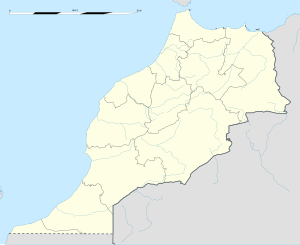Figuig
|
Figuig فكيك ⵉⴼⵢⵢⴻⵢ |
||
|---|---|---|
 |
||
|
||
| Location in Morocco | ||
| Coordinates: 32°7′0″N 1°13′37″W / 32.11667°N 1.22694°WCoordinates: 32°7′0″N 1°13′37″W / 32.11667°N 1.22694°W | ||
| Country |
|
|
| Region | Oriental | |
| Province | Figuig | |
| Area | ||
| • Total | 200 km2 (80 sq mi) | |
| Elevation | 900 m (3,000 ft) | |
| Population (2014) | ||
| • Total | 10,872 | |
| • Density | 54/km2 (140/sq mi) | |
| Time zone | WET (UTC+0) | |
| • Summer (DST) | WEST (UTC+1) | |
Figuig (Arabic: فكيك; Berber: ⵉⴼⵢⵢⴻⵢ) is a town in eastern Morocco near the Atlas Mountains, on the border with Algeria.
The town is built around an oasis of date palms, called Tazdayt, meaning "palm tree" in the Berber language, surrounded by rugged, mountainous wilderness. Modernization has somewhat raised the standard of living, and drawn much of the town's population away, so that it is now struggling to reach stability. Its population in 2014 was 10,872, down from a peak of 14,571 in 1982.
The Ksour Range is a mountainous area extending between Figuig and El Bayadh.
Figuig consists of seven different communities (Ighermawen in South Oran Berber dialect) which are: At-Wadday, At-Amar, At-Lamiz, At-Sliman, At-Annaj, At-Addi, Iznayen. A community territory is called an Agram, which is the word some local Berbers use to describe themselves in their tongue; plural Igramawan. The communities are usually made up of a fortified group of houses. Many Agrams are designed with defensive measures like watch-towers and heavy doors on the main entrances, which are closed at night, as well as a mazelike layout, called an Abrid (meaning "pathway" in Berber), which makes navigation for unwanted intruders extremely difficult.
Homes, or Tidriwin, are extended by building rooms over the alleyways; these extensions are referred to as Askif. Houses are built mainly with soil, though palm trunks (tizidin) and leaf-heads (tikachba, taratta) are used in roof construction. The arrival of electricity, plumbing, and concrete construction has not essentially altered the nature of Aghram building. However, modern age buildings are being built more and more in the newly appointed area's at the edge of each "Agram".
Aghrams are often centered on a plaza once used for communal gatherings and shopping. Arab nomads would exhibit merchandise like cooked butter (Udi), dried milk (Ibrassa), and sheep wool (Douft). However, due to lack of demand and western-influenced tastes, the plaza-markets have waned in both their variety and importance.
...
Wikipedia


